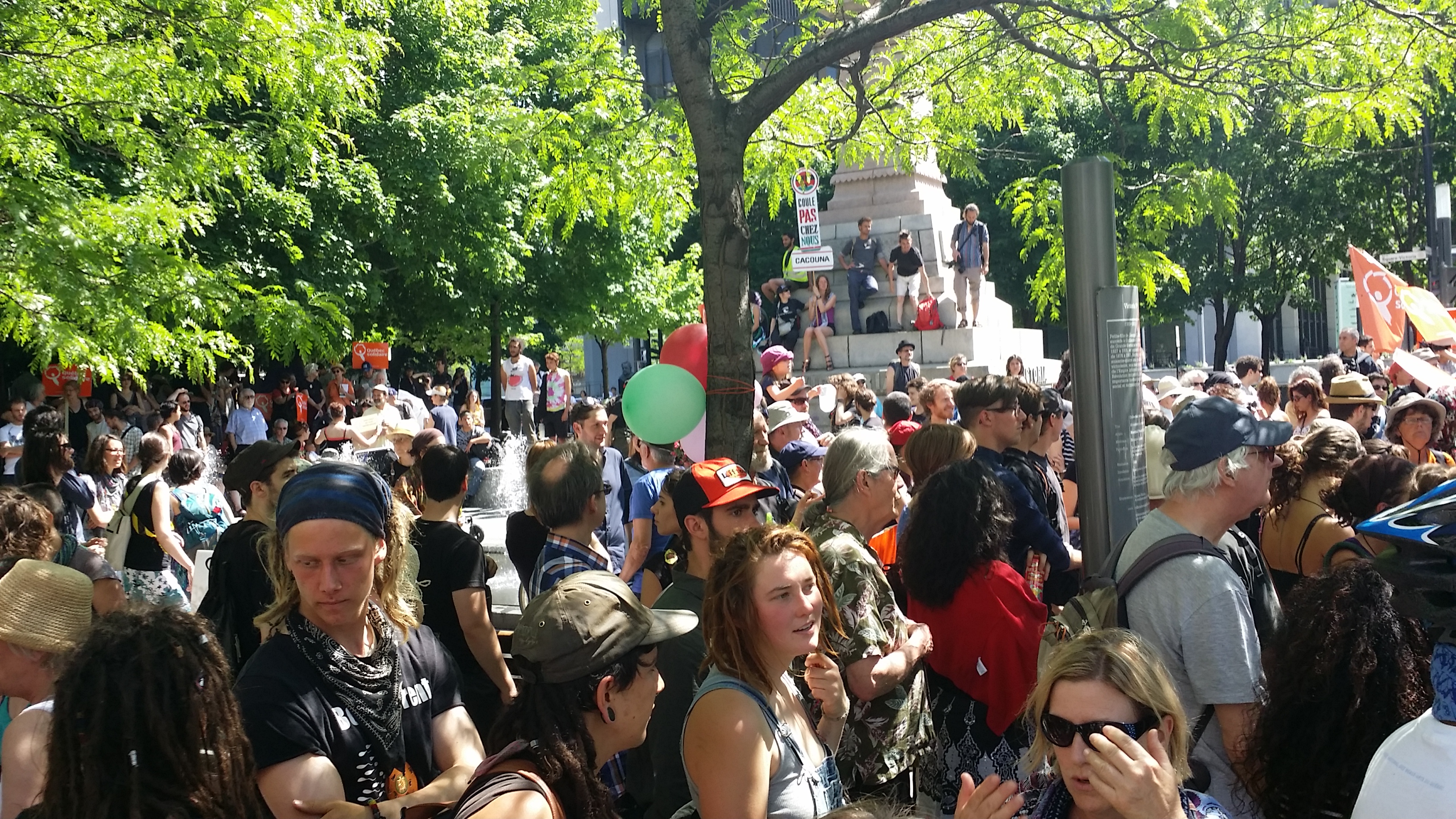June 7: Montreal
The Peoples for Mother Earth marchers have, for the second time — the first being in Levis — spent a more than one day in a city. This time, that city is Montreal: a city known for its large activist presence, especially since the 2012 student strike. The march arrived on June 6 and will leave on the 8th.
On the 7th, the marchers had organized a street demonstration to take place in Square Victoria, in the heart of Montreal’s storied financial district. The banks and finance companies which operate in the area are heavily invested in fossil fuel companies. Square Victoria itself, where the demonstration would take place, is surrounded by banks, the headquarters of Quebecor Media — one of many huge conglomerates in Quebec’s highly concentrated media industry — and the World Trade Center of Montreal.
Square Victoria was also the location of Occupy Montreal’s tent city. At that time, and since, it has been renamed by activists “The People’s Square.”
The demonstration was to begin at 2:00 in the afternoon, but the marchers were awake early. Groups went outside to various places in Mount-Royal; some went into coffee shops and handed out pamphlets, others played music in the park and discussed the coming demonstration with anyone who approached. Each group found numerous sympathetic individuals who proceeded to show up at the protest.
By the time 2:00 came around, The People’s Square was starting to fill up. The demonstration began slightly later than expected, at around 2:30, but by that time the square was packed from sidewalk to sidewalk. After a song by the Chorale du Peuple, Alyssa Symons-Belanger (one of the march’s organizers) took the microphone — which was plugged into a sound system on a horse’s carriage.
After the speech, the crowd took to the street. The horse and carriage led the crowd in repeated round trips over the block which surround the square. The route was chosen for multiple reasons. For one, Montreal’s municipal government passed a bylaw following the 2012 student called P6. This requires protest organizers to disclose routes to local police or face the risk of every protester receiving a $1,000 fine. The march decided during its organizational stage to disclose the route and avoid the fines, but to mock the bylaw by having the protest simply turn in circles. Just days before the 7th, the police decided to reject to route because of potential disruptions to hotels in the area — as the protest would take place over Grand Prix weekend. The marchers decided collectively to continue regardless with the pre-decided route as an act of civil disobedience.
The fact that the protest took place on Grand Prix weekend — where the gratuitous and unnecessary burning of fossil fuels is made into a citywide celebration — also made the “turning in circles” around the People’s Square something of a satire of that race. Other organizers saw the circle as an apt metaphor for dependence on oil; a “vicious circle,” as the demonstration was named.
Around 700 people showed up including many marchers who had showed up for some time in the past month but had to leave, members of various citizen’s organizations who specialize in environmental activism, and all three elected member of Quebec Solidaire (as well as a large contingent of their party members). The protesters, after each “lap” around the square, heard a different speech, by Indigenous leaders and others concerned about the tar sands’ expansion.
After an hour, the protesters — the majority of whom were wearing black shirts — heard a speech by an Indigenous leader who spoke of “breaking the vicious cycle.” At that time, the demonstrators removed their black shirts and revealed brightly coloured clothes underneath. This act was meant to symbolize the freeing of society from its dependence on oil.
After this happened, the march took to the streets again. They joined up with another demonstration organized by No One is Illegal, a group which agitates for the rights of immigrants in Canada. This was meant as a show of solidarity to a fight which is connected to that against climate change. The Global South is feeling the worst of climate change’s early effects, and this is leading many of its residents to seek refuge in the advanced capitalist countries of the Global North. The developed world has, as a response to an an uptick in global immigration, began to enact increasing stringent rules regarding who can enter a country and who can not.
Once that protest was finished in the late afternoon, the marchers were treated to a screening of multiple documentaries by Wapikoni Mobile — one of which was about Peoples for Mother Earth. By the end of the day, the marchers were tired but content about their day of action in the province’s most populous city.



